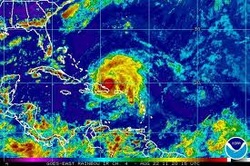
In the hours before Hurricane Irene strikes the East Coast, all businesses and organizations in the path of the storm need to be prepared to be offline for as much as two weeks or more, due to power losses, downed trees, washed out roads, lost Internet access, and lack of access to offices, stores, and other business locations.
In fact, David Paulison, former executive director of the Federal Emergency Management Agency (FEMA), says that “Small businesses that don’t have a plan in place generally don’t survive after a disaster, whether it’s a flood or a tornado…We see that anywhere from 40-60 percent of those that are hit like that simply don’t come back to business.”
We had the honor earlier this year of working on a joint initiative of USDA Rural Development, the NH Division of Economic Development, and the NH Community Development Finance Authority on “When Disaster Strikes,” a series of workshops focused on business continuity planning, public relations, and social media in natural and man-made disaster situations. (See allthreepresentations at the Division of Economic Development’s Slideshare channel.)
Social media has tremendous power and value for people and businesses during disasters. Sharing information on evacuation conditions, communicating with employees, notifying key stakeholders about your business outages, showing customers and clients the human side of what’s going on in your business, getting updated storm information, coordinating assistance in areas where it’s needed most…those are just some of the ways you can use social channels like blogs, Facebook, Twitter, YouTube, Flickr, and more to connect to the people and agencies that matter most.
Social Media Checklist for Business Disaster Preparedness There’s a free “Social Media Checklist for Business Disaster Preparedness” download from us at the Division of Economic Development’s Slideshare channel, too. While some steps you may not be able to complete in the next 48 hours, here are four things you can and should handle as quickly as possible.
1. Set Up Mobile Access. If you have a smartphone, be sure to install apps from social channels, like Twitter and Facebook, you already use personally and in business. If you don’t have a smartphone, you can still post updates to Facebook and Twitter using SMS text messaging, once you set up mobile access.
For your Facebook Profile, start at https://www.facebook.com/editaccount.php and go to the “Mobile” tab. For your Facebook Page, go to your admin panel (reached by clicking “Edit Page” when you’re on your page), look for the “Mobile” tab. For Twitter, once you’re logged in, click your name in the upper right, then in the drop down under “Settings,” go to the “Mobile” tab.
2. Keep Passwords Handy. Sometimes people store passwords in their web browsers and just forget what they are. Other times, people have so much on their minds in the midst of a disaster that they just plain forget what their passwords are! Passwords get changed at different times, some require numbers while others don’t, or special characters, or different minimum lengths…you get the idea.
It’s not a good idea to just have your passwords lying around the office or store, but kept in a locked fire safe…well, that’s a better idea. Make sure you’ve documented all your passwords for social sites (heck, for banking and insurance sites, too), in case you need to reference or share them on the fly.
3. Have a Back-up. If you can’t get to your social channels to post updates or communicate, is there someone else who can do it for you? It’s always a smart policy to have more than one Admin for a Facebook Page, for example, in case one person gets locked out of his or her account. Same concept in the event of a disaster – if you’re the only person with access, and you don’t have the time or means to control and communicate with your social channels, it’s going to look to the outside world like no one’s at the wheel of your business.
Find someone you trust to designate as a back-up for you – if not an employee or business partner, then a trusted spouse, relative, responsible friend, or relevant vendor, who can access and update channels for you in a time of need.
4. Create Emergency Agency Social Lists. FEMA has said it expects to concentrate more of its information sharing through social media channels in the event of a disaster. FEMA is on Facebook and Twitter, as are many other support agencies. Don’t forget, too, that economic development agencies also serve businesses in times of disaster. The US Economic Development Agency is on Facebook and Twitter – check in your state or region to see whether more localized agencies are there, too. Here in New Hampshire, for example, the state is on Facebook and Twitter, and shared a “Hurricane Irene Storm Awareness Update for NH Businesses” on their blog yesterday.
To track and receive information easily from business support agencies in Facebook – once you’ve gone to their pages and “Liked” them – go to the “Account” link in the top right of your window, select “Edit Friends,” then look for “+ Create a List” button at top right of the center column. In Twitter, click the “Lists” tab, then click “Create a list” link in the dialog box that appears.
Follow Real-time Hurricane Irene Information, Conversations, Resources, and Reactions on Twitter Here are a few other agencies to consider following on Twitter to keep on top of the Hurricane Irene buzz:
As of 2:30 am EST Saturday, “State of Emergency” and “Katrina” are trending topics on Twitter, and the popular hashtags following the threatening tropical cyclone include #hurricane, #irene, #hurricaneirene. The trending topics will change quickly and often, cluing you in to what’s nabbing people’s attention from a global perspective. So when “chatter” rises about hurricane information, you really get a sense of how much this storm is occupying the collective conversation.
A word about following hashtags and conversation threads on Twitter: Some of it might look like nonsense or unrelated trivia. Many people often jump into the stream of popular topics to crack jokes, get attention, showcase wit, and just plain contribute from their perspective. It’s human nature. However, there’s lots of really valuable insight, views, resources, timely updates, and full-throttle humanity in there. Check it out, and let us know what you think.
Web 2.0 Disaster Management Presentation If you have 45 minutes and want to take a deeper look at why social media is more relevant than ever to the disaster preparedness and business continuity process, the full presentation from the “When Disaster Strikes” initiative is below (and on Slideshare if you need it, too). Designed for business owners, entrepreneurs, and professionals using social media for business purposes, the presentation allows you to scan through the slides quickly or listen to the whole audio that accompanies it, which includes nine things you can do before, during, and after a disaster situation.
Web 2.0 Disaster Management


 RSS Feed
RSS Feed
